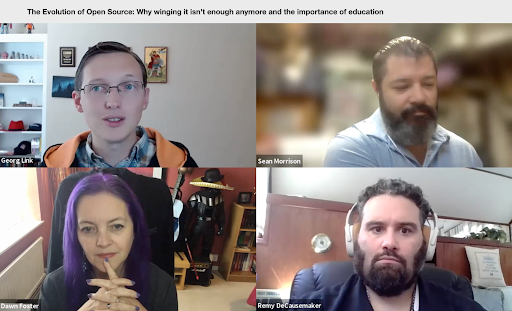Over the last two decades, the open source space has experienced dynamic change, from licensing and governance to the role open source plays in various industries. On August 23, a panel of open source experts, including VMware’s Director of Open Source Community Strategy Dawn Foster, spoke to these changing dynamics, how we navigate them and how education can address the growing needs of organizations involved with open technologies.
Georg Link, co-founder of the CHAOSS project, discussed how open source allows for easier collaboration. Dawn chimed in, noting that while many people still perceive open source as an uncontrolled entity run by volunteers, the whole practice has evolved drastically and has more structure than some people realize. Businesses are free to use open source to improve their own software. And while there are still countless volunteer contributors, companies are taking open source seriously and employing people to work on open source projects to the point where the majority of contributors in many projects are being paid to contribute.
In addition to licensing and open source’s evolution, our panelists discussed the ways people can make blunders while contributing to open source. Dawn offered three key reasons:
- Failing to collaborate with the open source project community before making a contribution. If a new contributor (or even an entire corporate team) goes off on their own to implement a certain change, it’s likely that they could end up spending time making a contribution that the community doesn’t want and ultimately rejects.
- Not spending enough time understanding the community that you’re joining. Every open source project is unique, and contribution processes vary by project. There’s a ton of valuable information in a project’s README file, good first issues and other contributing documents, so it’s important for new contributors to study these resources before they dive in.
- Believing that you need to start from scratch. In many communities, there can be various types of informal governance processes that aren’t documented. Quite a few people tend to avoid working on governance, so this could be a great place for a new contributor to start. Many new contributors believe they have to reinvent the wheel when it comes to creating documentation that explains how people work together and make decisions within a project. But there are plenty of governance documents and tools you can use from other projects to help inspire your own. Remember you can work smarter, not harder!
Next, the panel discussed what contributors should look for in order to identify a healthy and engaging community. Dawn suggested asking yourself the following four questions in order to identify open source project risks:
- Is the project governed under a neutral foundation?
- Can you identify the maintainers of the project? Are they employed by a variety of organizations?
- Does the project have robust security policies in place?
- Is there a defined leadership structure and ladder for new people to move into leadership roles?
The fact of the matter is that every open source community has risk. But by asking yourself these questions, you can identify any red flags within a community before you decide to get involved. By learning about the risks upfront, you’ll be better equipped to balance them and make more informed choices. (For more information on open source risk, check out Dawn’s blog series on licensing risk, contributor and organization risk, responsive and healthy communities and leadership and governance.)
Interested in getting involved in an open source project but not sure where to start? Some projects have mentoring or shadowing programs that will enable you to get the inside scoop on what it’s like to work on a certain project. If you have a specific interest in mind, you can sign up for a project’s office hours, meetings or other communication channels. For people who are brand new to open source and are looking for internship options, programs like Outreachy and Google Summer of Code are great ways to get involved.
Missed the webinar? Watch the recording here.
For more information, check out our post on how to contribute to open source and follow us on Twitter for the latest updates.







